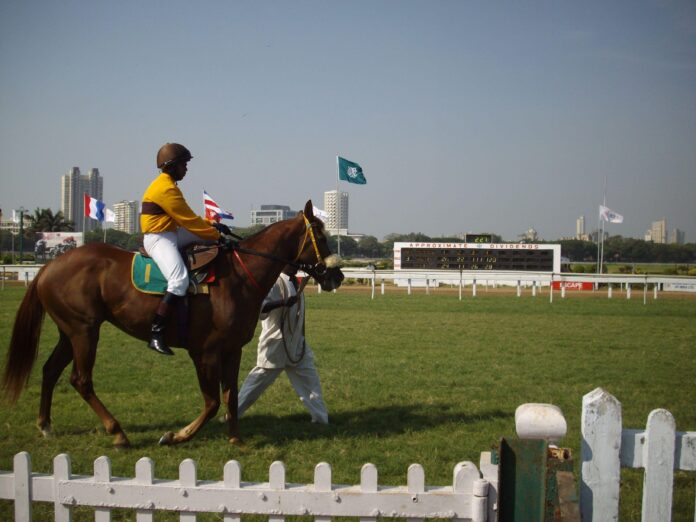Mumbai, India’s financial capital and most populous city, is to get its first major art fair this November. Art Mumbai (16-19 November) will take place on the Mahalaxmi Racecourse, a historic horse racing track in the city’s centre, and feature around 50 exhibitors, mostly from India. These include some of its leading galleries, such as Experimenter (Kolkata, Mumbai), Vadehra Art Gallery (New Delhi) and Chatterjee & Lal (Mumbai); they will be joined by smaller outfits such as Sumukha from Bangalore. Five overseas galleries specialising in South Asian art—including Grosvenor in London and Aicon from New York—will also show at the fair.
The launch of Art Mumbai is significant for India, where for the past 15 years only one major fair has been held: the India Art Fair (IAF) in New Delhi. IAF’s last event, which ran from 9-12 February 2023, saw 71 galleries take part—its largest edition to date. IAF’s organisers said that the fair’s growth was evidence of the recent strength of India’s contemporary art market, which according to a report by Indian Art Investor, saw its strongest year ever in terms of turnover in 2022.
While the Mumbai fair is comparatively boutique in size, its organisers are treating the inaugural edition as a “test run”. Future years will likely include international galleries selling blue-chip art, such as Continua and Lisson, both of which expressed interest to take part, according to Art Mumbai’s co-founder, Dinesh Vazirani. He will organise the fair along with his wife, Minal Vazirani, and the dealers Conor Macklin, the director of Grosvenor Gallery, and Nakul Dev Chawla, the founder of the online gallery Global Art Hub.
The Vaziranis are familiar figures in the Indian art world, having co-founded SaffronArt, one of India’s leading auction houses, headquartered in Mumbai. Dinesh Vazirani, who is the auction house’s chief executive, dismisses concerns from The Art Newspaper that his dominant position within India’s secondary art market poses a conflict of interest with his new role as a fair organiser and owner.
“In India there has always been a strong blurring of lines between the primary and secondary markets,” he says. “Galleries have become auction houses, and auction houses partner with galleries to do a lot of primary work. Moreover, with the internet being a levelling platform, tech is increasingly blurring the lines between primary and secondary and various selling platforms the world over. I also think that it’s important to remember that India, unlike other countries, started with an online model for auctions, and went to IRL [in real life] later. The rules we play by are not all the same.”
Art Mumbai is a “totally separate company” to SaffronArt, he continues, and the auction house is not an official promoter, although Saffronart’s non-profit foundation—run by a different team to the auction house—will have a booth at the fair.
The fair will be directed by Teesta Bhandare, a curator and collector from New Delhi who has spearheaded young collector’s events across India. “Mumbai’s collector base includes a growing, younger professional class that buys art differently to their Delhi counterparts,” Bhandare says. “They are a bit more experimental and less into brand names; they also care less about what their parents are buying—there isn’t as strong a sense of legacy in their taste.”
Comparisons between India’s two largest commercial art hubs endure for Vazirani too, who says that Mumbai has felt “somewhat neglected” since IAF and prominent New Delhi-based collectors such as Kiran Nadar shifted focus towards the capital. But this was not always the case: Vazirani argues that Mumbai is the birthplace of modern-day arts patronage in India, having birthed the Bombay Progressives, an artist group founded in the 1947, whose members—such as VS Gaitonde and SH Raza—command some of the highest prices of Indian artists at auction today. They were supported early in their careers by the city’s rich industrialist families, such as the Tatas and the Goenkas. And this wealth has only grown: Mumbai has more billionaires than either Singapore or San Francisco.
Such wealth is no better exemplified than by the newly opened Nita Mukesh Ambani Cultural Centre (NMACC), a cross-disciplinary arts venue in Mumbai funded by India’s second-richest family, the Ambanis. The centre is currently staging Maurizio Cattelan’s first solo exhibition in India, as well as the country’s first Mirror Room installation by Yayoi Kusama.
On a more micro scale, a number of new galleries showing emerging and mid-career artists have also opened in the city over the past two years, including XXL, Akara Contemporary and Apre Art House. This has been interpreted as a sign that Mumbai’s art scene has rebounded post-pandemic.
What Art Mumbai means in the long run for the New Delhi fair remains to be seen. Vazirani says that he approached IAF’s owner, the global fair company Angus Montgomery, to collaborate, but was told that they “were not ready”. Vazirani points out that, in comparison, Art Mumbai is “Indian owned” and will be “more personal” because its organisers know the galleries intimately.
It is no secret that IAF had been considering a Mumbai expansion for a number of years—a plan that never took off. A longstanding concern has been whether India possesses enough serious collectors to sustain more than one major art fair a year. While this may have been the case before, it is no longer, Vazirani believes, with the domestic market in rude health.
Beyond the promise of strong sales, Art Mumbai will also assert itself by tapping into what is perhaps the city’s best-known cultural export: Bollywood glamour. Vazirani says that he has been in touch with figures from Mumbai’s glittering film industry to stage a series of galas and parties that will make the fair “one to remember”.

























